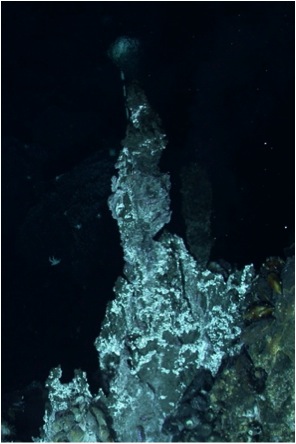After steaming 8 hours, the ship arrived at the Kilo Moana vent field, characterized by a basalt substrate, acidic pH (3.2-4), and a maximum temperature of 332 degrees Celsius. Jason II headed down to an approximate depth of 2620 meters carrying empty sample boxes, multiple sensors and one of the thermocouple arrays, and was brought back on board 12 hours later with sulfide chimney samples and water samples. Many large branching chimney structures were observed (photo below) along with many ledges, or flanges (see future blog post on the formation of flanges).
Scientists observe and document the events during a dive from the "Jason Van." In the photo below, the watch leader, Meg Tivey (center), is looking on with the Jason II pilot, Will Sellers (left) and navigator, Bob Waters (right) as Jason II just reaches the Kilo Moana vent field.
One of the objectives of this dive was to deploy a thermocouple array over the top of an actively venting chimney to investigate the colonization of microbes on newly precipitated chimney material. Mineral precipitation occurs as the hot, acidic, mineral-rich vent fluids mix with the cold surrounding ocean water. Thus, we can study the newly formed material on the thermocouple array (after recovery) and characterize the associated microbial community.

One of the big surprises when visiting Kilo Moana this time was the abundance of flanges. In 2005, we did not observe any flanges. This suggests that the geochemistry may have changed between 2005 and 2009.
 The array shown in the photo above was visited first and we were very happy to see a brand new "chimlet" growing out of the array cage. The white microbial biofilm can already be seen on the chimlet! We decided to keep this array down a little longer, so stay tuned for details on what we recover in the coming days. Nothing, however, could prepare us for what we were about to see as we approached the second array...
The array shown in the photo above was visited first and we were very happy to see a brand new "chimlet" growing out of the array cage. The white microbial biofilm can already be seen on the chimlet! We decided to keep this array down a little longer, so stay tuned for details on what we recover in the coming days. Nothing, however, could prepare us for what we were about to see as we approached the second array...  If you remember one of our earlier blog posts, "A microbial home in 72 hours!", what formed on this array after 10 days can be more aptly described as a microbial apartment complex! It even has vacancies for fellow organisms like shrimp and crabs!!
If you remember one of our earlier blog posts, "A microbial home in 72 hours!", what formed on this array after 10 days can be more aptly described as a microbial apartment complex! It even has vacancies for fellow organisms like shrimp and crabs!!  We were able to recover the majority of the chimney structure and can't wait to "see" what our analyses tell us about the microbial inhabitants and geochemical formation. A new array was placed in the same location that will be recovered after three days (see photo below). Who knows what type of structure we can expect to recover?!?
We were able to recover the majority of the chimney structure and can't wait to "see" what our analyses tell us about the microbial inhabitants and geochemical formation. A new array was placed in the same location that will be recovered after three days (see photo below). Who knows what type of structure we can expect to recover?!? 











































